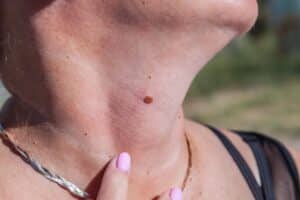 November is National Healthy Skin Month—a perfect time to focus on your skin health. One of the simplest and most effective ways to care for your skin is by performing regular self-exams, which can help you catch any unusual spots or changes early on.
November is National Healthy Skin Month—a perfect time to focus on your skin health. One of the simplest and most effective ways to care for your skin is by performing regular self-exams, which can help you catch any unusual spots or changes early on.
Dr. Stanley Skopit, a Board Certified Dermatologist and Diplomate of the National Board, has been helping patients protect their skin health since 1981. As a Fellow of Distinction and Past President of the American Osteopathic College of Dermatology (AOCD), Dr. Skopit and the team at Dania Dermatology in Dania, FL, are here to guide you through this essential routine for long-term skin wellness.
Why Skin Self-Exams Are Essential
Skin cancer is the most common cancer in the U.S., but it’s also one of the most treatable when caught early. Conducting a monthly self-exam can help you detect any new or changing spots on your skin, making it easier to catch potential issues before they develop further. Think of a skin self-exam as a regular part of your wellness routine, like brushing your teeth or exercising.
How to Conduct a Skin Self-Exam
A self-exam can be done in the comfort of your home with a full-length mirror and a hand mirror. Here’s a step-by-step guide:
- Find a well-lit room with a mirror where you can see your whole body.
- Start with your face and scalp, checking for new or unusual spots. Use a hand mirror or ask for help to examine your scalp thoroughly.
- Move down to your torso and back, checking your chest, abdomen, and sides. Use the hand mirror to inspect your back.
- Examine your arms and hands, looking carefully at each finger, under your nails, and in the armpits.
- Finish with your legs, feet, and soles, checking between your toes and under your toenails.
- Take your time, and use a phone or notebook to record any spots you want to monitor over time.
What to Look For
When examining your skin, the “ABCDE” rule helps identify potential issues:
- A – Asymmetry: One half doesn’t match the other.
- B – Border: Edges that are irregular or blurred.
- C – Color: Multiple colors or uneven pigmentation.
- D – Diameter: Spots larger than a pencil eraser.
- E – Evolving: Any change in size, shape, or color.
Beyond these, look for any new growths, sores that don’t heal, or spots that feel itchy or tender.
When to See a Dermatologist
If you notice any concerning spots or changes during your self-exam, don’t hesitate to reach out to a dermatologist. Sometimes, skin changes can be harmless, but it’s always better to consult a professional to ensure your peace of mind. Here at Dania Dermatology in Dania, FL, our skilled dermatologists provide comprehensive skin checks and are here to address any concerns you may have.
Your Skin Health Needs in Dania, FL
Caring for your skin is crucial to your well-being, and performing regular self-exams is a proactive approach. If you’re in Dania, FL, or nearby, prioritize your skin health with a professional evaluation at Dania Dermatology. Early detection matters—contact us at 954-807-9433 to schedule your consultation and protect your skin health.
The post National Healthy Skin Month: How to Conduct a Skin Self-Exam appeared first on Dania Dermatology.







